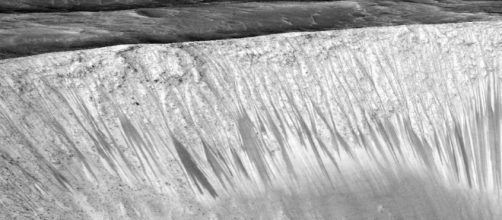Since it was announced that there existed evidence of liquid water in Mars, scientists have been thinking on the best strategies used to approach the sites that have been detected to show evidence of liquid water. Besides dealing with the steepness of slopes, they also have to avoid contaminating the sites of research with earth microbes on the rover.
Evidence of water
On March 18, 2013, NASA announced the evidence of mineral hydration in various rock samples analyzed by the rover´s instruments. Rocks with veins and nodules formations that suggested the flow of liquid water were also found.
In September 2015, NASA announced the discovery of hydrated brine streams on recurring slope lineae (RSL), which are some kind of gullies seen on earth, It was confirmed that the streaks resulted from the streams of water in the downhill surface of slopes.
Gullies
These are some type of ground formations that are created by running water, flowing down on a hillside. They resemble large channels or small valleys, meters to tens of meters in depth. When a gully is in the process of formation, the streams of flowing water can be abundant, producing a big trench into the soil on which it is running.
Safety precautions
Scientists think that the sites under inspection should be approached with certain precautions.
They fear that earth´s organisms present hidden between the machinery of the rover could present potential contamination of the samples under inspection. The RSL are of special concern and careful precaution should be taken to prevent contamination, as they contain what´s considered the prerequisites for microbial life.
Scientists have detected RSL prospective sites for study 5 km (3.1 miles) up Mount Sharp. The rover should use its Chemical there to image the suspected sites. The main objective will be to monitor the sites and see if any changes occur over time and consider other causes for the SLR formation, such as dry avalanches.
Conclusion
Pending approval for an extended time for the mission, Curiosity rover will keep its travel upward the stratified environment of Mount Sharp.
The rover will be able to take a closer observation of the sites where dark streaks have been located and will also have a better view to take images distances away -- potential water sites on the Mars surface.
Curiosity´s main goal is to study the Martian environment and assess whether the red planet was or is appropriate for the development of life. The rover´s extended mission will allow scientists to assess spacecraft capability for future science missions on Mars ‘exploration.

